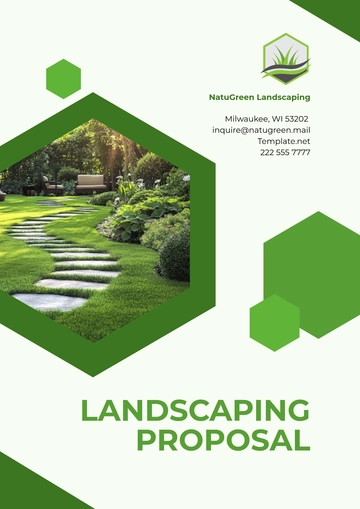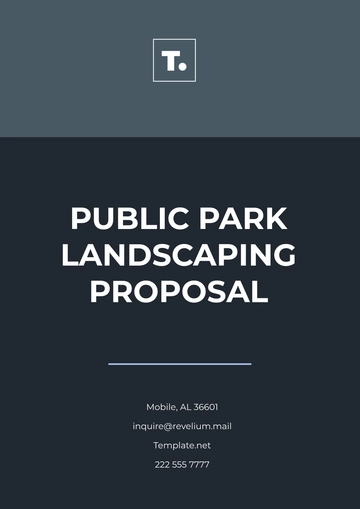Free Native Plant Landscaping Proposal

Prepared by: [Your Name]
Date: [Date]
I. Introduction
This proposal outlines a comprehensive plan for implementing a native plant landscaping project. The goal is to enhance the property's aesthetic appeal while promoting environmental sustainability. By selecting and incorporating native plants, we aim to reduce water consumption, improve biodiversity, and create a low-maintenance landscape that thrives naturally in the local environment.
II. Site Analysis
A thorough analysis of the site has been conducted to ensure the success of the proposed landscaping plan. The key factors taken into consideration include:
A. Existing Conditions
The property currently consists of an open lawn area with limited plant diversity. The soil is slightly clay-based, and the climate is characterized by hot summers and mild winters, with occasional drought conditions.
B. Soil Type
Soil testing reveals that the ground is moderately fertile but may benefit from drainage improvements. The proposed plants will be selected based on their ability to thrive in these soil conditions.
C. Climate and Microclimate
The area experiences an average annual rainfall of 25 inches and high temperatures in summer, making drought-tolerant native plants ideal for the landscaping project. Shaded areas may require plants suited for lower light conditions.
III. Design Plan
The design plan incorporates native plants that complement the local ecosystem while adding beauty and structure to the property. The layout will include a mix of ornamental, ground-cover, and flowering plants, as well as a small pollinator garden.
A. Layout and Zoning
Front Yard: A combination of native shrubs and wildflowers will frame the entrance, providing visual interest and supporting local pollinators.
Backyard: A blend of grasses, perennials, and flowering plants will create a low-maintenance garden that thrives with minimal irrigation.
Edges and Borders: Drought-tolerant ground cover plants will be installed along borders to prevent soil erosion and add texture.
B. Key Design Elements
Native Flowering Plants: Echinacea, Black-eyed Susan, and Purple Coneflower.
Ground Covers: Creeping Thyme and Blue Star Creeper.
Shrubs and Bushes: Wax Myrtle and Serviceberry.
Trees: Red Maple and Eastern Redbud.
IV. Plant Selection
The plant species selected for this project are all native to the region and will thrive in the local climate and soil conditions. These plants are known for their low maintenance requirements, drought tolerance, and ecological benefits.
A. Flowering Plants
Purple Coneflower (Echinacea purpurea): Known for its vibrant flowers and ability to attract pollinators.
Black-eyed Susan (Rudbeckia hirta): A hardy, colorful plant that tolerates a variety of soil conditions.
B. Shrubs
Wax Myrtle (Myrica cerifera): A fragrant shrub that provides habitat for wildlife and is tolerant of drought.
Serviceberry (Amelanchier canadensis): A small tree with edible fruit that supports birds and pollinators.
C. Ground Covers
Creeping Thyme (Thymus serpyllum): A low-growing, drought-tolerant herb that provides excellent ground cover.
Blue Star Creeper (Isotoma fluviatilis): A fast-spreading ground cover with small blue flowers.
D. Trees
Red Maple (Acer rubrum): A native tree that provides shade and attracts birds.
Eastern Redbud (Cercis canadensis): A small tree with beautiful spring blossoms, perfect for ornamental use.
V. Installation Plan
The installation will be carried out in several phases to ensure a smooth and efficient process.
A. Phase 1: Site Preparation
Clear the Area: Remove any non-native plants and debris from the site.
Soil Preparation: Amend the soil as needed, adding organic material to improve drainage and fertility.
B. Phase 2: Plant Installation
Planting Layout: Arrange the plants according to the design plan, ensuring proper spacing for growth.
Planting: Dig holes, place the plants, and water them thoroughly to establish roots.
C. Phase 3: Mulching and Watering
Mulching: Apply a layer of organic mulch around each plant to retain moisture and suppress weeds.
Irrigation: Initial watering will be provided until the plants are established.
VI. Maintenance Plan
To ensure the long-term success of the landscaping, the following maintenance practices will be implemented:
A. Watering
Initial Watering: The plants will be watered deeply during the first few weeks after installation to help them establish.
Ongoing Maintenance: Watering will be minimal after establishment, relying on natural rainfall once the plants are established.
B. Pruning and Deadheading
Pruning: Light pruning will be required to maintain shape and remove dead growth.
Deadheading: Removing spent flowers will encourage continued blooming in certain species.
C. Weed Control
Manual Weeding: Weeds will be removed by hand to prevent competition for nutrients and water.
Mulching: A second layer of mulch will be added annually to suppress weeds.
D. Pest Management
Integrated Pest Management: Regular checks will be conducted for pests. Native plant species typically attract fewer pests, but any issues will be addressed using eco-friendly methods.
VII. Budget
The estimated cost for this project includes the plants, materials, installation, and maintenance:
Plants: $1,200
Soil Amendments and Mulch: $500
Installation Labor: $1,000
Maintenance (First Year): $300
Total Estimated Cost: $3,000
VIII. Timeline
The project will be completed in four weeks, with the following milestones:
Week 1: Site preparation and soil amendments.
Week 2-3: Plant installation and mulching.
Week 4: Final watering and inspection.
- 100% Customizable, free editor
- Access 1 Million+ Templates, photo’s & graphics
- Download or share as a template
- Click and replace photos, graphics, text, backgrounds
- Resize, crop, AI write & more
- Access advanced editor
Showcase your expertise in sustainable landscaping with Template.net’s Native Plant Landscaping Proposal Template. This editable and customizable template enables you to highlight native plant selections, environmental benefits, and project costs. Perfect for environmentally-conscious clients, this template is editable in our Ai Editor Tool, offering a seamless way to personalize every detail of your proposal.
You may also like
- Business Proposal
- Research Proposal
- Proposal Request
- Project Proposal
- Grant Proposal
- Photography Proposal
- Job Proposal
- Budget Proposal
- Marketing Proposal
- Branding Proposal
- Advertising Proposal
- Sales Proposal
- Startup Proposal
- Event Proposal
- Creative Proposal
- Restaurant Proposal
- Blank Proposal
- One Page Proposal
- Proposal Report
- IT Proposal
- Non Profit Proposal
- Training Proposal
- Construction Proposal
- School Proposal
- Cleaning Proposal
- Contract Proposal
- HR Proposal
- Travel Agency Proposal
- Small Business Proposal
- Investment Proposal
- Bid Proposal
- Retail Business Proposal
- Sponsorship Proposal
- Academic Proposal
- Partnership Proposal
- Work Proposal
- Agency Proposal
- University Proposal
- Accounting Proposal
- Real Estate Proposal
- Hotel Proposal
- Product Proposal
- Advertising Agency Proposal
- Development Proposal
- Loan Proposal
- Website Proposal
- Nursing Home Proposal
- Financial Proposal
- Salon Proposal
- Freelancer Proposal
- Funding Proposal
- Work from Home Proposal
- Company Proposal
- Consulting Proposal
- Educational Proposal
- Construction Bid Proposal
- Interior Design Proposal
- New Product Proposal
- Sports Proposal
- Corporate Proposal
- Food Proposal
- Property Proposal
- Maintenance Proposal
- Purchase Proposal
- Rental Proposal
- Recruitment Proposal
- Social Media Proposal
- Travel Proposal
- Trip Proposal
- Software Proposal
- Conference Proposal
- Graphic Design Proposal
- Law Firm Proposal
- Medical Proposal
- Music Proposal
- Pricing Proposal
- SEO Proposal
- Strategy Proposal
- Technical Proposal
- Coaching Proposal
- Ecommerce Proposal
- Fundraising Proposal
- Landscaping Proposal
- Charity Proposal
- Contractor Proposal
- Exhibition Proposal
- Art Proposal
- Mobile Proposal
- Equipment Proposal
- Student Proposal
- Engineering Proposal
- Business Proposal





























